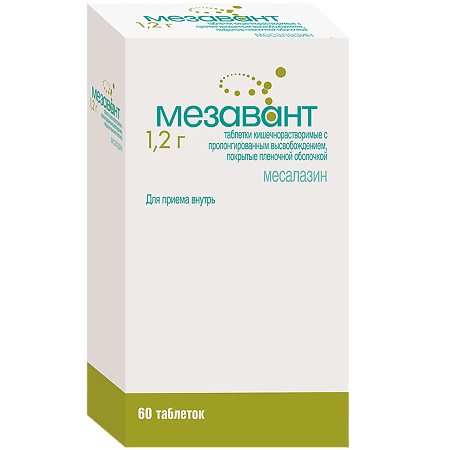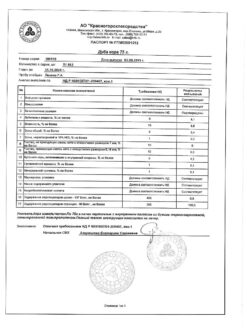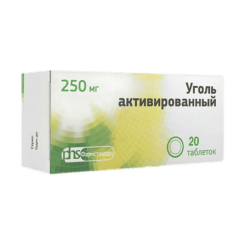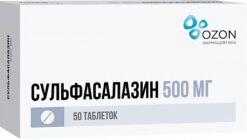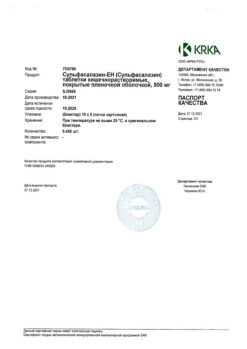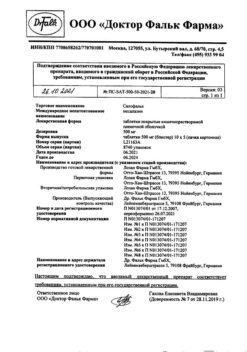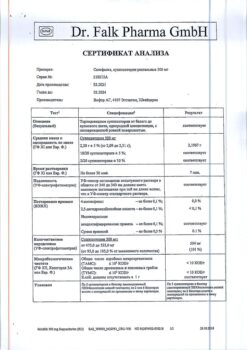No products in the cart.
Mezavant, 1,2g 60 pcs.
€115.64 €100.22
Description
Pharmacotherapeutic group: Inflammatory bowel medicine.
ATX code: A07EC02
Pharmacological properties Pharmacodynamics
em>Mechanism of action
Mesalazine is a 5-aminosalicylic acid derivative. The mechanism of action of mesalazine is not fully understood, but the drug has been found to have a local anti-inflammatory effect on intestinal epithelial cells. In patients with chronic inflammatory bowel disease, synthesis of arachidonic acid metabolites by cyclooxygenase and lipoxygenase pathways is increased in the mucosa. It is possible that mesalazine attenuates inflammation by inhibiting cyclooxygenase and inhibiting prostaglandin synthesis in the colon. Mesalazine has the ability to inhibit the activation of nuclear factor kappa-B, NFkB, and hence the production of key proinflammatory cytokines. Recently, it has been suggested that a deficiency of nuclear PPAR-γ receptors (the γ form of receptors activated by peroxisome proliferator-activated receptors) may be associated with the development of ulcerative colitis. PPAR-γ receptor agonists have been shown to be effective in ulcerative colitis. Accumulating evidence suggests that the effect of mesalazine may be realized by acting on PPAR-γ receptors.
Pharmacokinetics
The tablet of the drug Mesavant has a core containing 1.2 g of mesalazine in a multimatrix system. The core is surrounded by a shell of a copolymer of methacrylic acid and methyl methacrylate taken in ratios (1:1) to (1:2); the composition of the shell is chosen so that the release of mesalazine begins only when the pH reaches about 7.
The mechanism of action of mesalazine is not fully understood, but mesalazine (5-ASC) is thought to have local action, so the clinical effect of the drug does not correlate with the pharmacokinetic characteristics of the substance. The main route of excretion of mesalazine is metabolism to N-acetyl-5-aminosalicylic acid, which is pharmacologically inactive.
absorption
The studies with gamma scintigraphy showed that, after a single dose of 1.2 g on an empty stomach in healthy volunteers, mesalazine passes rapidly and unchanged through the upper gastrointestinal tract. This reveals traces of radioactive isotope-labeled indicator throughout the colon, indicating that mesalazine enters these parts of the gastrointestinal tract. Complete disintegration of the Mesavant tablet and release of mesalazine was observed after approximately 17.4 hours.
After administration to healthy volunteers at a dose of 2.4 g or 4.8 g once daily for 14 days, absorption of mesalazine was 21 to 22% of the dose taken.
After a single dose in healthy volunteers on an empty stomach at doses of 1.2 g, 2.4 g and 4.8 g, the plasma concentration of mesalazine was determined 2 hours (median) after administration and reached the maximum value after 9 – 12 hours (median). Pharmacokinetic parameters were characterized by wide variability between patients. The level of systemic exposure (AUC, area under the concentration-time curve) for mesalazine at doses ranging from 1.2 g to 4.8 g of mesalazine was proportional to the dose taken. The maximum plasma concentration (Cmax) of mesalazine in the dose range of 1.2 g to 2.4 g increased approximately in direct proportion, whereas in the dose range of 2.4 g to 4.8 g mesalazine increased in proportion to the dose but to a lesser extent, with a normalized dose at 4.8 g averaging 74% of a dose equal to 2.4 g, based on geometric mean values. In a pharmacological study of single and multiple doses of 2.4 g and 4.8 g of mesalazine with common food, mesalazine was detectable in plasma after 4 hours, with maximum concentration reached 8 hours after a single dose. At equilibrium (which was usually reached after 2 days of administration), 5-ASC accumulation was 1.1 and 1.4 times higher for doses of 2.4 g and 4.8 g, respectively, than for a single dose.
Single-dose administration of mesalazine at a dose of 4.8 g with fatty foods was accompanied by a delayed phase of absorption. Under these conditions, mesalazine was detectable in plasma approximately 4 hours after ingestion. However, fat-rich foods increased the systemic exposure of mesalazine (mean Cmax by 91%, mean AUC by 16%) compared with fasting food.
In a pharmacokinetic study of mesalazine, healthy volunteers of both sexes (n=71, 28 young (18 to 35 years), 28 elderly (65 to 75 years), and 15 older than 75 years) took mesalazine at a single dose of 4.8 g on an empty stomach. Increased age was accompanied by increased systemic exposure of mesalazine and its metabolite N- acetyl-5-aminosalicylic acid (calculated based on AUC0-t AUC0-∞ and Cmax) approximately doubled, but had no effect on the proportion of mesalazine absorbed. Increased age was accompanied by a delay in the apparent half-life of mesalazine, although variability between patients was pronounced. Systemic exposure in selected subjects was inversely correlated with renal function as assessed by estimated creatinine clearance.
Distribution
Mesalazine is thought to have a similar distribution profile to other mesalazine-containing drugs. Mesalazine has a relatively low volume of distribution of approximately 18 liters, indicating minimal systemic distribution. At in vitro plasma concentrations of mesalazine up to 2.5 µg/mL and concentrations of N-acetyl 5-aminosalicylate up to 10 µg/mL, binding to plasma proteins was 43% and 78-83%, respectively.
Metabolism
The only major metabolite of mesalazine is the pharmacologically inactive N-acetyl 5-aminosalicylic acid. It is formed under the action of N-acetyltransferase-1 in the cells of the liver and cytosol cells of the intestinal mucosa.
Evolution
Absorbed mesalazine is excreted mainly by the kidneys after acetylation to N- acetyl-5-aminosalicylic acid. However, a small amount of the drug is excreted by the kidneys and unchanged. Less than 8% of the absorbed dose of mesalazine (21-22% of the administered dose is absorbed) is excreted unchanged in the urine within 24 hours, while more than 13% is excreted as N-acetyl-5-aminosalicylic acid. The apparent terminal elimination half-life of mesalazine and its major metabolite after doses of 2.4 g and 4.8 g were, on average, 7-9 and 8-12 hours, respectively.
In adults, mean renal clearance (CLR) was 1.8 l/h and 2.9 l/h at single doses of 2.4 g and 4.8 g, respectively, and slightly higher on day 14 of multiple dosing: 5.5 l/h and 6.4 l/h at doses of 2.4 g/day and 4.8 g/day. Mean renal clearance of the metabolite was higher, being approximately 12-15 l/h after single and multiple doses of mesalazine at doses of 2.4 g/d and 4.8 g/d.In pediatric patients, mean renal clearance of 5-ASA at equilibrium ranged from approximately 5.0 to 6.5 l/h (83-108 ml/min), similar to that observed in adult subjects. There was a tendency for CLR to decrease with increasing dose, and individual CLR estimates varied widely. The mean CLR of N-acetyl-5-aminosalicylic acid ranged from 10.0 to 16.2 L/h (166-270 mL/min) with a tendency to decrease with increasing dose.
Special patient groups
Patients with hepatic impairment
There are no data on the use of mesalazine in patients with hepatic impairment. After a single dose of 4.8 g of mesalazine, systemic exposure of mesalazine in elderly patients (older than 65 years, with an average creatinine clearance of 68-76 ml/min) was superior to that in younger patients (18-35 years old, with an average creatinine clearance of 124 ml/min) by up to 2 times.
Patients with renal impairment
The systemic exposure in an individual analysis was inversely correlated with renal function as assessed by creatinine clearance.
Elderly patients
Pharmacokinetics data in the elderly have not been investigated.
Potential effects on the safe use of mesalazine in clinical practice in elderly patients should be considered. In addition, in patients with impaired renal function, the associated decreased excretion rate and increased systemic concentration of mesalazine may pose an increased risk of nephrotoxic adverse reactions (see section “Cautions”).
Gender
In various clinical studies of mesalazine, the AUC value of mesalazine in plasma was found to be 2 times higher in women than in men.
Race
Based on limited pharmacokinetic data, the pharmacokinetics of 5-ASA and N-acetyl-5-aminosalicylic acid appear to be comparable in subjects of European and Hispanic origin.
Indications
Indications
Induction and maintenance of remission according to clinical and endoscopic parameters in patients with mild or moderate ulcerative colitis.
Pharmacological effect
Pharmacological effect
Pharmacotherapeutic group: anti-inflammatory intestinal agent.
ATX code: A07EC02
Pharmacological properties
Pharmacodynamics
Mechanism of action
Mesalazine is a derivative of 5-aminosalicylic acid. The mechanism of action of mesalazine has not been fully studied, but it has been found that the drug has a local anti-inflammatory effect on intestinal epithelial cells. In patients with chronic inflammatory bowel disease, the synthesis of arachidonic acid metabolites through the cyclooxygenase and lipoxygenase pathways is enhanced in the mucous membrane. It is possible that mesalazine reduces inflammation by inhibiting cyclooxygenase and inhibiting prostaglandin synthesis in the colon. Mesalazine has the ability to inhibit the activation of nuclear factor kappa B – NFκB and, consequently, the production of key pro-inflammatory cytokines. Recently, it has been suggested that deficiency of the nuclear receptor PPAR-γ (the γ form of peroxisome proliferator-activated receptor) may be associated with the development of ulcerative colitis. PPAR-γ receptor agonists have been shown to be effective in ulcerative colitis. Accumulating evidence indicates that the effect of mesalazine may be exerted by acting on PPAR-γ receptors.
Pharmacokinetics
The Mezavant tablet has a core containing 1.2 g of mesalazine in a multi-matrix system. The core is surrounded by a shell of a copolymer of methacrylic acid and methyl methacrylate, taken in ratios (1:1) and (1:2); The composition of the shell is selected in such a way that the release of mesalazine begins only when the pH reaches about 7.
The mechanism of action of mesalazine is not fully understood, but it is believed that mesalazine (5-ASA) has a local effect, so the clinical effect of the drug does not correlate with the pharmacokinetic characteristics of the substance. The main route of elimination of mesalazine is metabolism to N-acetyl-5-aminosalicylic acid, which is pharmacologically inactive.
Suction
Studies using gamma scintigraphy have shown that after a single dose of 1.2 g of the drug in healthy volunteers on an empty stomach, mesalazine quickly and unchanged passes through the upper gastrointestinal tract. In this case, traces of a radiolabeled indicator are detected throughout the colon, which indicates the entry of mesalazine into these parts of the gastrointestinal tract. Complete disintegration of the Mezavant tablet and release of mesalazine was observed after approximately 17.4 hours.
After administration of the drug to healthy volunteers at a dose of 2.4 g or 4.8 g once daily for 14 days, mesalazine absorption was 21–22% of the dose taken.
After a single dose of 1.2 g, 2.4 g and 4.8 g of the drug to healthy volunteers on an empty stomach, the concentration of mesalazine in plasma was determined 2 hours (median) after administration and reached a maximum value after 9 – 12 hours (median). Pharmacokinetic parameters were characterized by wide variability between patients. The level of systemic exposure (AUC, area under the concentration-time curve) for mesalazine when taking the drug in the dose range from 1.2 g to 4.8 g of mesalazine was proportional to the dose taken. The maximum plasma concentration (Cmax) of mesalazine in the dose range from 1.2 g to 2.4 g increased approximately directly proportionally, while in the dose range from 2.4 g to 4.8 g mesalazine increased proportionally to the dose, but to a lesser extent, with the normalized dose value at 4.8 g averaging 74% of the dose equal to 2.4 g based on geometric means. In a pharmacological study of single and multiple doses of mesalazine at a dose of 2.4 g and 4.8 g with regular food, mesalazine was detected in the blood plasma after 4 hours, the maximum concentration was reached 8 hours after a single dose. At steady state (which was usually achieved after dosing for 2 days), 5-ASA accumulation was 1.1 and 1.4 times higher for the 2.4 g and 4.8 g doses, respectively, than with a single dose.
A single dose of mesalazine 4.8 g with a fatty meal was accompanied by a slower absorption phase. Under these conditions, mesalazine was detected in plasma approximately 4 hours after administration. However, a high-fat meal increased systemic mesalazine exposure (mean Cmax by 91%, mean AUC by 16%) compared with fasting levels.
In a pharmacokinetic study of mesalazine, healthy volunteers of both sexes (n=71, 28 young (18 – 35 years), 28 elderly (65 – 75 years) and 15 over 75 years) took the drug mesalazine in a single dose of 4.8 g on an empty stomach. Increasing age was accompanied by an approximately twofold increase in systemic exposure of mesalazine and its metabolite N-acetyl-5-aminosalicylic acid (calculated based on AUC0-t AUC0-∞ and Cmax), but did not affect the proportion of mesalazine absorbed. Increasing age was associated with a slowing of the apparent half-life of mesalazine, although there was considerable inter-patient variability. Systemic exposure in individual subjects was inversely correlated with renal function as assessed by estimated creatinine clearance.
Distribution
Mesalazine is believed to have a similar distribution profile to other mesalazine-containing drugs. Mesalazine has a relatively small volume of distribution of approximately 18 L, indicating minimal systemic distribution. When the concentration of mesalazine in blood plasma in vitro was up to 2.5 μg/ml and the concentration of N-acetyl-5-aminosalicylate was up to 10 μg/ml, binding to plasma proteins was 43% and 78-83%, respectively.
Metabolism
The only major metabolite of mesalazine is the pharmacologically inactive N-acetyl-5-aminosalicylic acid. It is formed under the action of N-acetyltransferase-1 in liver cells and the cytosol of intestinal mucosal cells.
Removal
Absorbed mesalazine is excreted mainly by the kidneys after acetylation to N-acetyl-5-aminosalicylic acid. However, the drug is excreted in small quantities by the kidneys and unchanged. Less than 8% of the absorbed dose of mesalazine (21-22% of the dose taken is absorbed) is excreted unchanged in the urine within 24 hours, while more than 13% is excreted as N-acetyl-5-aminosalicylic acid. The apparent terminal half-lives of mesalazine and its major metabolite following dosing of 2.4 g and 4.8 g averaged 7-9 and 8-12 hours, respectively.
In adults, mean renal clearance (CLR) was 1.8 L/h and 2.9 L/h for single doses of 2.4 g and 4.8 g, respectively, and slightly higher on day 14 of multiple doses: 5.5 L/h and 6.4 L/h for doses of 2.4 g/day and 4.8 g/day. The mean renal clearance of the metabolite was higher, approximately 12-15 L/h, after single and multiple doses of mesalazine at a dose of 2.4 g/day and 4.8 g/day. In pediatric patients, the mean renal clearance of 5-ASA at steady state ranged from approximately 5.0 to 6.5 L/h (83-108 ml/min), which is similar to what was observed in adult subjects. There was a trend toward decreased CLR with increasing dose, and individual CLR estimates varied widely. The average CLR value of N-acetyl-5-aminosalicylic acid varied from 10.0 to 16.2 l/h (166-270 ml/min) with a tendency to decrease with increasing dose.
Special patient groups
Patients with liver failure
There are no data on the use of mesalazine in patients with hepatic impairment. After a single dose of mesalazine at a dose of 4.8 g, the systemic exposure of mesalazine in elderly patients (over 65 years of age, with an average creatinine clearance of 68-76 ml/min) was up to 2 times higher than that in younger patients (18-35 years, with an average creatinine clearance of 124 ml/min).
Patients with renal failure
Systemic exposure when analyzed individually was inversely correlated with renal function assessed by creatinine clearance.
Elderly patients
Pharmacokinetic data have not been studied in the elderly.
The potential impact on the safe use of mesalazine in clinical practice in elderly patients should be considered. In addition, in patients with impaired renal function, the associated decrease in elimination rate and increase in systemic concentrations of mesalazine may represent an increased risk of developing nephrotoxic adverse reactions (see section “Special Instructions”).
Floor
In various clinical studies of mesalazine, the plasma AUC of mesalazine in women was 2 times higher than in men.
Race
Based on limited pharmacokinetic data, the pharmacokinetics of 5-ASA and N-acetyl-5-aminosalicylic acid appear to be comparable in subjects of European and Hispanic origin.
Special instructions
Special instructions
Severe skin adverse reactions
Severe cutaneous adverse reactions (SCARs), including Stevens-Johnson syndrome (SJS) and toxic epidermal necrolysis (TEN), have been reported in association with treatment with mesalazine. Discontinue mesalazine at the first appearance of signs and symptoms of severe skin reactions, such as skin rash, mucosal lesions, or any other signs of hypersensitivity.
Kidney or liver failure
Cases of renal dysfunction, including the development of minimal change nephropathy, acute/chronic interstitial nephritis and renal failure, have been described when using drugs containing mesalazine or that are prodrugs of mesalazine. Patients with established mild to moderate renal impairment should exercise caution when taking the drug. All patients are recommended to undergo a renal function test before starting treatment and then repeat it at least 2 times a year during treatment.
Pulmonary dysfunction
Patients with chronic pulmonary function impairment, especially asthma, are at risk of hypersensitivity reactions and should be closely monitored.
Pathological changes in blood composition (blood dyscrasia)
Blood dyscrasia after treatment with mesalazine was rarely observed. If a patient develops unexplained bleeding, bruising, purpura, anemia, fever, or sore throat, a hematologic evaluation should be performed. If blood dyscrasia is suspected, treatment should be discontinued.
Cardiac hypersensitivity reactions
Rare cases of cardiac hypersensitivity reactions (myocarditis and pericarditis) have been described when using Mezavant or other drugs containing mesalazine. This drug should be prescribed with caution to patients with diseases predisposing to the development of myocarditis or pericarditis. If such a hypersensitivity reaction is suspected, drugs containing mesalazine should not be reused.
Acute intolerance syndrome
The use of mesalazine is associated with the development of acute intolerance syndrome, which in some cases is difficult to distinguish from an exacerbation of inflammatory bowel disease. Although the incidence of this phenomenon is not well established, it was reported to be 3% in controlled clinical trials of mesalazine or sulfasalazine. Symptoms include abdominal cramps, severe abdominal pain, bloody diarrhea, sometimes fever, headache and rash. If the development of acute intolerance syndrome is suspected, the drug containing mesalazine should be immediately discontinued and its use should not be resumed.
Liver dysfunction
Increases in liver enzyme levels have been reported in patients taking medications containing mesalazine. It is recommended to use mesalazine with caution in patients with impaired liver function.
Allergy to sulfasalazine
Caution should be exercised when treating patients allergic to sulfasalazine due to the potential risk of cross-sensitivity reactions between sulfasalazine and mesalazine.
Upper gastrointestinal obstruction
Organic or functional obstruction of the upper gastrointestinal tract may slow down the development of the effect of the drug.
Sodium content
The drug contains less than 1 mmol sodium (23 mg) at the maximum recommended dose (4 tablets), which can be interpreted as “sodium free”.
Nephrolithiasis
Cases of nephrolithiasis have been reported with the use of mesalazine, including stones containing 100% mesalazine. During treatment, it is recommended to ensure adequate fluid intake.
Interaction with laboratory test results
The use of mesalazine may lead to a false test result showing increased levels of normetanephrine in the urine. Such results are possible when using liquid chromatography with electrochemical detection due to the similarity of the chromatograms of normetanephrine and the main metabolite of mesalazine, N-acetyl-5-aminosalicylic acid (N-Ac-5-ACA). Therefore, an alternative selective method should be used to determine normetanephrine in urine.
Impact on the ability to drive vehicles and machinery
There have been no studies of the effect of mesalazine on the ability to drive vehicles and operate machinery. Mesalazine is not thought to affect this ability. However, patients should be warned about the possibility of developing dizziness and drowsiness while using the drug. If the described adverse events occur, you should refrain from performing these activities.
Active ingredient
Active ingredient
Mesalazine
Composition
Composition
1 tablet contains:
Active ingredient: mesalazine 1200.0 mg.
Excipients: carmellose sodium (7MF) 11.3 mg, carmellose sodium (7HXF) 38.7 mg, carnauba wax 5.0 mg, stearic acid 10.0 mg, colloidal silicon dioxide 2.0 mg, sodium carboxymethyl starch (type A) 30.0 mg, talc 11.0 mg, magnesium stearate 14.0 mg.
Tablet shell: talc 17.8 mg, methacrylic acid and methyl methacrylate copolymer [1:1] 16.0 mg, methacrylic acid and methyl methacrylate copolymer [1:2] 16.0 mg, triethyl citrate 3.2 mg, titanium dioxide 6.0 mg, red iron oxide dye 3.0 mg, macrogol 6000 1.0 mg.
Pregnancy
Pregnancy
Pregnancy
Experience with the use of mesalazine in pregnant women is limited. Mesalazine penetrates the placental barrier, but the concentration of the substance in the fetus is significantly lower than in adults when used in therapeutic doses. Animal studies have not revealed any adverse effects of mesalazine on pregnancy, embryonic/fetal development, childbirth or postnatal development of the offspring.
Adverse effects (including blood abnormalities such as leukopenia, thrombocytopenia, and anemia) have been reported in infants whose mothers took mesalazine during pregnancy.
Mezavant should be used during pregnancy only if the potential benefit to the mother outweighs the potential risk to the fetus. Caution should be exercised when taking high doses of the drug.
Breastfeeding period
Mesalazine is excreted into breast milk in small quantities, and the metabolite N-acetyl-5-aminosalicylic acid is excreted in higher concentrations. During breastfeeding, mesalazine should be used with caution and only if the possible benefit to the mother outweighs the potential risk to the baby. Cases of sporadic acute diarrhea have been reported in infants whose mothers took mesalazine while breastfeeding.
Fertility
Available data do not show a consistent effect of mesalazine on male fertility.
Contraindications
Contraindications
• Hypersensitivity to salicylates (including mesalazine) or any excipient of the drug.
• Severe renal failure (glomerular filtration rate < 30 ml/min/1.73 m2).
• Severe liver failure.
• Children under 10 years of age and/or body weight 50 kg or less (due to the lack of data on the safety and effectiveness of the drug in this category of patients).
With caution
• Mild or moderate renal failure.
• Mild to moderate liver failure.
• Chronic pulmonary dysfunction (bronchial asthma).
• Diseases predisposing to the development of myo- or pericarditis.
• The drug is prescribed with caution to patients who are allergic to sulfasalazine due to possible cross-hypersensitivity to mesalazine.
• Associated skin lesions such as atopic dermatitis and atopic eczema, which predispose to more severe photosensitivity reactions.
• Organic or functional obstruction of the upper gastrointestinal tract may delay the onset of action of the drug.
• Pregnancy, breastfeeding period.
Side Effects
Side Effects
The most common adverse reactions (ADRs) reported during clinical trials of Mezavant in 3611 patients were colitis (including ulcerative colitis, 5.8%), abdominal pain (4.9%), headache (4.5%), changes in liver function tests (2.1%), diarrhea (2.0%), and nausea (1.9%).
The safety profile in the pediatric population is consistent with the safety profile in studies in adults and during post-registration use. Adverse reactions listed below are presented according to the classification according to organ damage and organ systems (MEDDRA) and frequency: very often (≥1/10); often (≥ 1/100 – < 1/10); uncommon (≥ 1/1,000 - < 1/100); rare (≥ 1/10,000 - < 1/1,000); frequency unknown (frequency cannot be estimated from available data).
Blood and lymphatic system disorders
uncommon: *thrombocytopenia
rare: *agranulocytosis
frequency unknown: *aplastic anemia, *leukopenia, *neutropenia, *pancytopenia
Immune system disorders
uncommon: facial swelling
frequency unknown: *hypersensitivity, anaphylactic shock, angioedema, Stevens-Johnson syndrome (SJS), drug rash with eosinophilia and systemic manifestations (DRESS), toxic epidermal necrolysis (TEN)
Nervous system disorders
often: *headache
uncommon: dizziness, drowsiness, tremor
frequency unknown: increased intracranial pressure, neuropathy
Disorders of the hearing organ and labyrinth
uncommon: ear pain Cardiac disorders uncommon: tachycardia
frequency unknown: *myocarditis, *pericarditis
Vascular disorders
common: hypertension
uncommon: hypotension
Respiratory, thoracic and mediastinal disorders
uncommon: *pharyngolaryngeal pain
frequency unknown: hypersensitivity pneumonitis (including interstitial pneumonitis, allergic alveolitis, eosinophilic pneumonitis), bronchospasm, pleurisy Gastrointestinal disorders
often: bloating, *abdominal pain, colitis, *diarrhea, dyspepsia, vomiting, flatulence, nausea
uncommon: pancreatitis, rectal polyp
Disorders of the liver and biliary tract
often: *changes in liver function tests (for example, alanine aminotransferase, aspartate aminotransferase, bilirubin)
frequency unknown: hepatitis, hepatotoxicity, cholelithiasis
Skin and subcutaneous tissue disorders
common: skin itching, *skin rash uncommon: acne, alopecia, urticaria rare: photosensitivity
Musculoskeletal and connective tissue disorders
often: arthralgia, back pain
uncommon: myalgia
frequency unknown: SLE syndrome, lupus-like syndrome
Renal and urinary tract disorders
rare: *renal failure
frequency unknown: *interstitial nephritis, *nephrotic syndrome,
*nephrolithiasis
Disorders of the genital organs and breast
frequency unknown: oligospermia (reversible)
General and administration site disorders
often: asthenia, weakness, increased body temperature*
*Cm. “Special instructions”
Description of selected adverse reactions:
Increased intracranial pressure
Increased intracranial pressure with papilledema (idiopathic intracranial hypertension or benign intracranial hypertension) has been reported with the use of mesalazine. If not diagnosed promptly, this condition can lead to narrowing of visual fields and permanent vision loss. If this syndrome develops, mesalazine should be discontinued if possible.
Photosensitivity
More severe reactions have been reported in patients with pre-existing skin conditions such as atopic dermatitis and atopic eczema.
Interaction
Interaction
Studies in healthy adult volunteers have shown no clinically significant interactions between mesalazine and the 4 most commonly used antimicrobials (amoxicillin, ciprofloxacin, metronidazole and sulfamethoxazole).
However, there is data on the interaction of mesalazine-containing drugs with the following drugs:
• Caution is recommended when using mesalazine concomitantly with drugs that have nephrotoxic effects, including nonsteroidal anti-inflammatory drugs (NSAIDs) and azathioprine, as this may increase the risk of adverse renal effects.
• Mesalazine inhibits thiopurine methyltransferase activity. Caution is recommended when using mesalazine concomitantly with azathioprine or 6-mercaptopurine and/or any other drugs that cause myelotoxicity, as this may increase the risk of blood cell disorders, bone marrow failure and related complications.
• The use of coumarin anticoagulants, such as warfarin, may lead to a decrease in anticoagulant activity. If this combination is necessary, prothrombin time should be carefully monitored.
Overdose
Overdose
The drug Mezavant is an aminosalicylate; Signs of salicylate intoxication include tinnitus, vertigo, headache, confusion, drowsiness, pulmonary edema, dehydration as a result of increased sweating, vomiting and diarrhea, hyperventilation, hypoglycemia. disturbance of electrolyte balance and blood pH, hyperthermia.
In case of acute overdose, it is necessary to use standard methods of treating salicylate intoxication. Fluid and electrolyte imbalances should be corrected with appropriate intravenous therapy. Adequate renal function should be maintained.
Storage conditions
Storage conditions
Store in original packaging at a temperature not exceeding 25 °C. Keep out of the reach of children.
Shelf life
Shelf life
2 years.
Do not use after the expiration date indicated on the package.
Manufacturer
Manufacturer
Cosmo S.p.A., Italy
Additional information
| Shelf life | 2 years. Do not use after the expiration date stated on the package. |
|---|---|
| Conditions of storage | Store in the original package at the temperature not more than 25 °С. Keep out of reach of children. |
| Manufacturer | Cosmo S.p.A., Italy |
| Medication form | enteric soluble tablets |
| Brand | Cosmo S.p.A. |
Related products
Buy Mezavant, 1,2g 60 pcs. with delivery to USA, UK, Europe and over 120 other countries.

